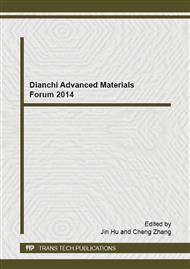p.132
p.136
p.140
p.145
p.149
p.153
p.158
p.165
p.170
Effect of Controlling Concentration on the Properties of SnO2 Nanocystalline for Dye Sensitized Solar Cells
Abstract:
The study of dye-sensitized solar cells (DSCs) based on nanocrystalline films of high band gap semiconductors is a progressive field of research that is being carried out by scientists in a wide range of laboratories. To improve the conversion efficiency of the DSCs, the SnO2 nanorots photocurrent, the effect of controlling concentration on the properties of SnO2 nanocrystalline were investigated via the hydrothermal method, and characterized by XRD, HRTEM, BET and Absorption spectrum. Though analysis the results, the conclusion is shown the pure SnO2 is preparation, the prepared SnO2 nanocrystalline under 0.05mol/L shows the particle-shape crystalline, the surface area of SnO2 nanocrystalline is 102.1683m2/g. The prepared SnO2 nanocrystalline under 1mol/L the fiber-shape crystalline, the surface area of SnO2 nanocrystalline is 79.7591m2/g. The absorbance of SnO2 nanocrystalline shows the strong absorption in the ultraviolet ray range, the absorbance of synthesized SnO2 nanocrystalline under the concentration of SnCl4 solution for 1mol/L shows the higher value.
Info:
Periodical:
Pages:
149-152
Citation:
Online since:
November 2014
Authors:
Keywords:
Price:
Сopyright:
© 2014 Trans Tech Publications Ltd. All Rights Reserved
Share:
Citation:


